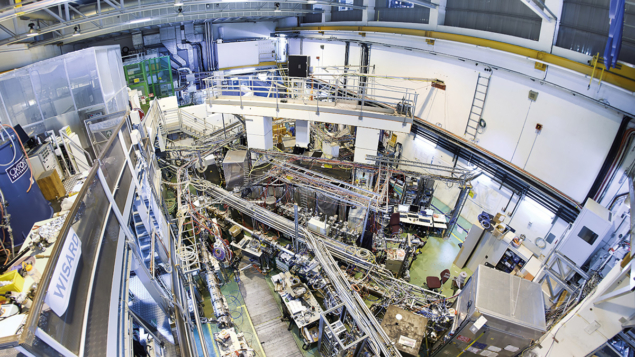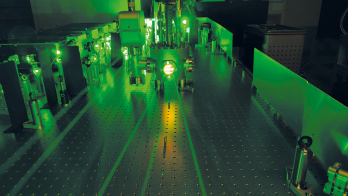
The observation at CERN’s ISOLDE facility of a long-sought decay of the thorium-229 nucleus marks a key step towards a clock that could outperform today’s most precise atomic timekeepers. Publishing the results in Nature, an international team has used ISOLDE’s unique facilities to measure, for the first time, the radiative decay of the metastable state of thorium-229m, opening a path to direct laser-manipulation of a nuclear state to build a new generation of nuclear clocks.
Today’s best atomic clocks, based on periodic transitions between two electronic states of an atom such as caesium or aluminium held in an optical lattice, achieve a relative systematic frequency uncertainty below 1 × 10–18, meaning they won’t lose or gain a second over about 30 billion years. Nuclear clocks would exploit the periodic transition between two states in the vastly smaller atomic nucleus, which couple less strongly to electromagnetic fields and hence are less vulnerable to external perturbations. In addition to offering a more precise timepiece, nuclear clocks could test the constancy of fundamental parameters such as the fine structure or strong-coupling constants, and enable searches for ultralight dark matter (CERN Courier September/October 2022 p32).
Higher precision
In 2003 Ekkehard Peik and Christian Tamm of Physikalisch-Technische Bundesanstalt in Germany proposed a nuclear clock based on the transition between the ground state of the thorium-229 nucleus and its first, higher-energy state. The advantage of the 229mTh isomer compared to almost all other nuclear species is its unusually low excitation level (~8 eV), which in principle allows direct laser manipulation. Despite much effort, researchers have not succeeded until now in observing the radiative decay – which is the inverse process of direct laser excitation – of 229mTh to its ground state. This allows, among other things, the isomer’s energy to be determined to higher precision.
In a novel technique based on vacuum-ultraviolet spectroscopy, lead author Sandro Kraemer of KU Leuven and co-workers used ISOLDE to generate an isomeric beam with atomic mass number A = 229, following the decay chain 229Fr → 229Ra → 229Ac → 229Th/229mTh. A fraction of 229Ac decays to the metastable, excited state of 229Th, the isomer 229mTh. To achieve this, the team incorporated the produced 229Ac into six separate crystals of calcium flouride and magnesium flouride at different thicknesses. They measured the radiation emitted when the isomer relaxes to its ground state using an ultraviolet spectrometer, determining the wavelength of the observed light to be 148.7 nm. This corresponds to an energy of 8.338 ± 0.024 eV – seven times more precise than the previous best measurements.
Our study marks a crucial step in the development of lasers that would make such a clock tick
“ISOLDE is currently one of only two facilities in the world that can produce actinium-229 isotopes in sufficient amounts and purity,” says Kraemer. “By incorporating these isotopes in calcium fluoride or magnesium fluoride crystals, we produced many more isomeric thorium-229 nuclei and increased our chances of observing their radiative decay.”
The team’s novel approach of producing thorium-229 nuclei also made it possible to determine the lifetime of the isomer in the magnesium fluoride crystal, which helps to predict the precision of a thorium-229 nuclear clock based on this solid-state system. The result (16.1 ± 2.5 min) indicates that a clock precision which is competitive with that of today’s most precise atomic clocks is attainable, while also being four orders of magnitude more sensitive to a number of effects beyond the Standard Model.
“Solid-state systems such as magnesium fluoride crystals are one of two possible settings in which to build a future thorium-229 nuclear clock,” says the team’s spokesperson, Piet Van Duppen of KU Leuven. “Our study marks a crucial step in this direction, and it will ease the development of lasers with which to drive the periodic transition that would make such a clock tick.”
Further reading
S Kraemer et al. 2023 Nature 617 706.








